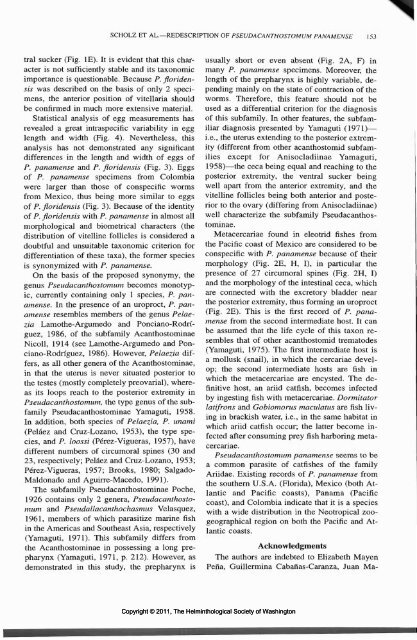The Helminthological Society of Washington - Peru State College
The Helminthological Society of Washington - Peru State College
The Helminthological Society of Washington - Peru State College
Create successful ePaper yourself
Turn your PDF publications into a flip-book with our unique Google optimized e-Paper software.
SCHOLZ ET AL.—REDESCRIPTION OF PSEUDACANTHOSTOMUM PANAMENSE 153<br />
tral sucker (Fig. IE). It is evident that this character<br />
is not sufficiently stable and its taxonomic<br />
importance is questionable. Because P. floridensis<br />
was described on the basis <strong>of</strong> only 2 specimens,<br />
the anterior position <strong>of</strong> vitellaria should<br />
be confirmed in much more extensive material.<br />
Statistical analysis <strong>of</strong> egg measurements has<br />
revealed a great intraspecific variability in egg<br />
length and width (Fig. 4). Nevertheless, this<br />
analysis has not demonstrated any significant<br />
differences in the length and width <strong>of</strong> eggs <strong>of</strong><br />
P. panamense and P. floridensis (Fig. 3). Eggs<br />
<strong>of</strong> P. panamense specimens from Colombia<br />
were larger than those <strong>of</strong> conspecific worms<br />
from Mexico, thus being more similar to eggs<br />
<strong>of</strong> P. floridensis (Fig. 3). Because <strong>of</strong> the identity<br />
<strong>of</strong> P. floridensis with P. panamense in almost all<br />
morphological and biometrical characters (the<br />
distribution <strong>of</strong> vitelline follicles is considered a<br />
doubtful and unsuitable taxonomic criterion for<br />
differentiation <strong>of</strong> these taxa), the former species<br />
is synonymized with P. panamense.<br />
On the basis <strong>of</strong> the proposed synonymy, the<br />
genus Pseudacanthostomum becomes monotypic,<br />
currently containing only 1 species, P. panamense.<br />
In the presence <strong>of</strong> an uroproct, P. panamense<br />
resembles members <strong>of</strong> the genus Pelaezia<br />
Lamothe-Argumedo and Ponciano-Rodriguez,<br />
1986, <strong>of</strong> the subfamily Acanthostominae<br />
Nicoll, 1914 (see Lamothe-Argumedo and Ponciano-Rodriguez,<br />
1986). However, Pelaezia differs,<br />
as all other genera <strong>of</strong> the Acanthostominae,<br />
in that the uterus is never situated posterior to<br />
the testes (mostly completely preovarial), whereas<br />
its loops reach to the posterior extremity in<br />
Pseudacanthostomum, the type genus <strong>of</strong> the subfamily<br />
Pseudacanthostominae Yamaguti, 1958.<br />
In addition, both species <strong>of</strong> Pelaezia, P. unami<br />
(Pelaez and Cruz-Lozano, 1953), the type species,<br />
and P. loossi (Perez-Vigueras, 1957), have<br />
different numbers <strong>of</strong> circumoral spines (30 and<br />
23, respectively; Pelaez and Cruz-Lozano, 1953;<br />
Perez-Vigueras, 1957; Brooks, 1980; Salgado-<br />
Maldonado and Aguirre-Macedo, 1991).<br />
<strong>The</strong> subfamily Pseudacanthostominae Poche,<br />
1926 contains only 2 genera, Pseudacanthostomum<br />
and Pseudallacanthochasmus Velasquez,<br />
1961, members <strong>of</strong> which parasitize marine fish<br />
in the Americas and Southeast Asia, respectively<br />
(Yamaguti, 1971). This subfamily differs from<br />
the Acanthostominae in possessing a long prepharynx<br />
(Yamaguti, 1971, p. 212). However, as<br />
demonstrated in this study, the prepharynx is<br />
usually short or even absent (Fig. 2A, F) in<br />
many P. panamense specimens. Moreover, the<br />
length <strong>of</strong> the prepharynx is highly variable, depending<br />
mainly on the state <strong>of</strong> contraction <strong>of</strong> the<br />
worms. <strong>The</strong>refore, this feature should not be<br />
used as a differential criterion for the diagnosis<br />
<strong>of</strong> this subfamily. In other features, the subfamiliar<br />
diagnosis presented by Yamaguti (1971)—<br />
i.e., the uterus extending to the posterior extremity<br />
(different from other acanthostomid subfamilies<br />
except for Anisocladiinae Yamaguti,<br />
1958)—the ceca being equal and reaching to the<br />
posterior extremity, the ventral sucker being<br />
well apart from the anterior extremity, and the<br />
vitelline follicles being both anterior and posterior<br />
to the ovary (differing from Anisocladiinae)<br />
well characterize the subfamily Pseudacanthostominae.<br />
Metacercariae found in eleotrid fishes from<br />
the Pacific coast <strong>of</strong> Mexico are considered to be<br />
conspecific with P. panamense because <strong>of</strong> their<br />
morphology (Fig. 2E, H, I), in particular the<br />
presence <strong>of</strong> 27 circumoral spines (Fig. 2H, I)<br />
and the morphology <strong>of</strong> the intestinal ceca, which<br />
are connected with the excretory bladder near<br />
the posterior extremity, thus forming an uroproct<br />
(Fig. 2E). This is the first record <strong>of</strong> P. panamense<br />
from the second intermediate host. It can<br />
be assumed that the life cycle <strong>of</strong> this taxon resembles<br />
that <strong>of</strong> other acanthostomid trematodes<br />
(Yamaguti, 1975). <strong>The</strong> first intermediate host is<br />
a mollusk (snail), in which the cercariae develop;<br />
the second intermediate hosts are fish in<br />
which the metacercariae are encysted. <strong>The</strong> definitive<br />
host, an ariid catfish, becomes infected<br />
by ingesting fish with metacercariae. Dormitator<br />
latifrons and Gobiomorus maculatus are fish living<br />
in brackish water, i.e., in the same habitat in<br />
which ariid catfish occur; the latter become infected<br />
after consuming prey fish harboring metacercariae.<br />
Pseudacanthostomum panamense seems to be<br />
a common parasite <strong>of</strong> catfishes <strong>of</strong> the family<br />
Ariidae. Existing records <strong>of</strong> P. panamense from<br />
the southern U.S.A. (Florida), Mexico (both Atlantic<br />
and Pacific coasts), Panama (Pacific<br />
coast), and Colombia indicate that it is a species<br />
with a wide distribution in the Neotropical zoogeographical<br />
region on both the Pacific and Atlantic<br />
coasts.<br />
Acknowledgments<br />
<strong>The</strong> authors are indebted to Elizabeth Mayen<br />
Pena, Guillermina Cabanas-Caranza, Juan Ma-<br />
Copyright © 2011, <strong>The</strong> <strong>Helminthological</strong> <strong>Society</strong> <strong>of</strong> <strong>Washington</strong>
















